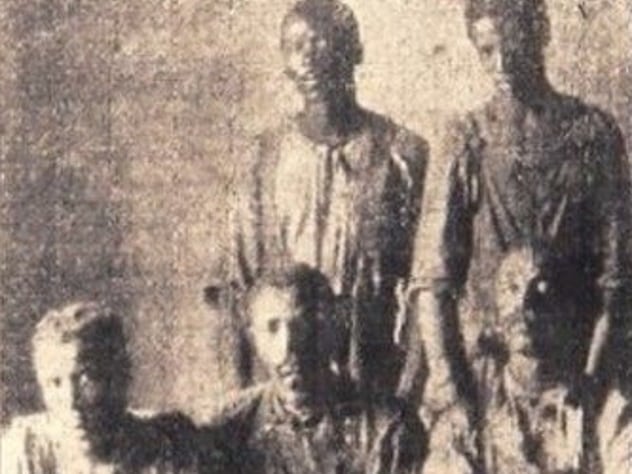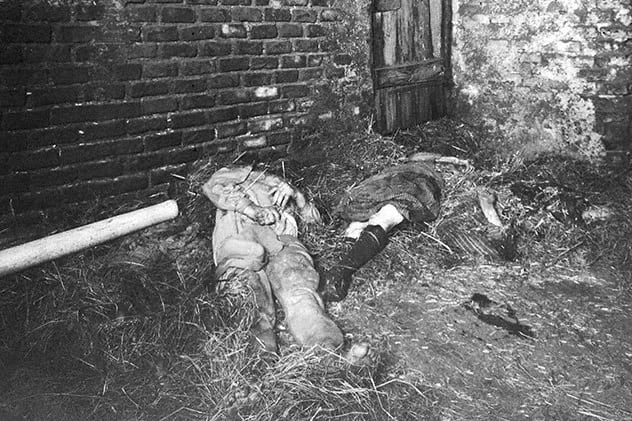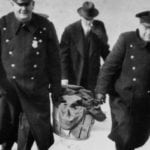 Mysteries
Mysteries  Mysteries
Mysteries  History
History 10 Surprising Stories About the Texas Rangers
 Humans
Humans 10 Philosophers Who Were Driven Mad by Their Own Theories
 Miscellaneous
Miscellaneous 10 Video-Game-Worthy Weapons and Armors from History
 Weird Stuff
Weird Stuff 10 Psychics Who Accurately Predicted Wartime Events
 The Arts
The Arts 10 Pieces of Art Inspired by a Broken Heart
 Health
Health 10 Science Fiction-Sounding New Medical Treatments
 History
History 10 Surprising Facts About the Father of Submarine Warfare
 Space
Space Ten Astonishing New Insights into Alien Worlds
 Weird Stuff
Weird Stuff 10 Bizarre Summer Solstice Rituals Still Practiced Today
 Mysteries
Mysteries Top 10 Haunting Facts About the Ghost Ship MV Alta
 History
History 10 Surprising Stories About the Texas Rangers
 Humans
Humans 10 Philosophers Who Were Driven Mad by Their Own Theories
Who's Behind Listverse?

Jamie Frater
Head Editor
Jamie founded Listverse due to an insatiable desire to share fascinating, obscure, and bizarre facts. He has been a guest speaker on numerous national radio and television stations and is a five time published author.
More About Us Miscellaneous
Miscellaneous 10 Video-Game-Worthy Weapons and Armors from History
 Weird Stuff
Weird Stuff 10 Psychics Who Accurately Predicted Wartime Events
 The Arts
The Arts 10 Pieces of Art Inspired by a Broken Heart
 Health
Health 10 Science Fiction-Sounding New Medical Treatments
 History
History 10 Surprising Facts About the Father of Submarine Warfare
 Space
Space Ten Astonishing New Insights into Alien Worlds
 Weird Stuff
Weird Stuff 10 Bizarre Summer Solstice Rituals Still Practiced Today
10 Terrifying Facts About The Man From The Train
How can you quantify or qualify serial killers? They are all horrible. They are all awful. They are all worthy of scorn. However, some are upheld as worse than others. Ted Bundy, the charismatic and handsome necrophile, is the archetype of the charming sociopath who managed to convince family and friends that he was completely “normal.” Countess Elizabeth Bathory, who may have killed as many as 650 people,[1] is the quintessential noble killer—a pampered slaughterer of the Early Modern Period who was only caught because she killed a fellow aristocrat.
Oddly enough, the man possibly responsible for killing over 100 individuals is almost totally unknown. This killer, who struck again and again in the United States and Canada between 1897 and 1912 (he may have killed as late as 1922), is known simply as “the Man from the Train.” First outed by writers Bill James and Rachel McCarthy James in their book The Man from the Train, the blood trail of this serial killer is astounding. That blood trail will be dissected in this list.
10 The Kansas Murders

On the afternoon of June 6, 1912, the bodies of Rollin D. Hudson and his wife Anna were found by neighbors at around 4:00 PM. Both had been murdered with an ax. As reported by the Miami Republican of Miami County, Kansas, the Hudsons’ heads were all but obliterated by several blows delivered from the blunt side of an ax.
Two years earlier, on December 10, 1910, another Kansas couple, the Bernhardt family, were also murdered with an ax. Again, the killer in this instance used the blunt side. In the Hudson case, local rumor speculated that the murders were the result of Anna’s infidelity. Added to these cruel jabs was the rumor of the pig-faced man—an unknown boarder at a local rooming house who supposedly asked far too many questions about the murders.[2]
Bill and Rachel James believe that the Man from the Train committed the murders. These crimes bore all the trademarks of this elusive killer. Namely, the Man from the Train attacked families during the early morning hours, used an ax taken from the family’s house, killed with the blunt side of the tool, and always picked victims who lived close to railroad tracks.
9 The Alabama Murders

One of the key points of the book The Man from the Train is the theory that the serial killer worked as a lumberjack. As a result, the murderer frequently took seasonal logging jobs. That is why ax murders occurred in the lumbering communities of Oregon, Washington, Texas, Maine, Virginia, Georgia, and Florida. In 1906, the Man from the Train struck in Alabama.
Sometime during the night between February 7 and 8, 1906, the entire Christmas family was murdered inside their home. In total, three people were killed, including 61-year-old Confederate Army veteran Jeremy Christmas. According to the James authors, the Cottonwood murders, of which not too much is known, are connected with other aspects of the larger pattern of the Man from the Train’s crimes. Notably, the mysterious serial killer liked to kill close to or on state lines. The state lines of Florida-Alabama and Florida-Georgia were some of his favorite hunting grounds.
Similarly, the crime in Cottonwood is important because it conformed to the Man from the Train’s modus operandi of attacking homes located near the first train stop past a state line.[3]
8 The Trenton Corners Murders

Trenton Corners, New Jersey, no longer exists. However, in 1900, Trenton Corners was a small town in Central New Jersey that was half-white and half-black. On November 17, 1900, an awful discovery was made—the entire Van Lieu family had been murdered by someone wielding the blunt side of an ax. The Van Lieu house was just 5 kilometers (3 mi) from Trenton Junction, the nearest train stop.[4]
For the Mercer County authorities in 1900, the Van Lieu murders were an open-and-shut case. Local ruffian Bob Hensen was quickly arrested and charged with the crime. Hensen, who had prior convictions for larceny and assault, reportedly had a fight with the Van Lieu family on November 6 after he brought them a stolen chicken. On December 27, 1901, Hensen was executed by the state of New Jersey after just a five-day trial.
Unfortunately, this was not the last time that someone else was killed for the crimes committed by the Man from the Train.
7 The Murder Of The Lyerly Family

The case of the Lyerly family of North Carolina is best-known for a subsequent crime—the August 7, 1906, lynching of three black men named Nease Gillespie (seated right), John Gillespie (Nease’s son, standing right), and Jack Dillingham (seated left). All three were hanged by a Rowan County lynch mob for the murders of the white Lyerly family. Amazingly, the mob originally rounded up eight suspects in the case but let five go after subjecting them to an impromptu trial.
According to the James authors, these men were innocent. Like other victims, the Lyerlys lived in small town near a railroad stop. They were killed in their sleep by a man using the blunt side of an ax that he had found at the residence. This ax was then washed clean and left at the scene (both of which were common tactics of the Man from the Train). Other indications that this was a Man from the Train crime was the fact that the killer set the house on fire following the murders and left money in plain sight.[5] Regarding the latter point, author Bill James thinks that the Man from the Train actually left his own money at his crime scenes.
6 The Virginia Murders

On September 21, 1909, six members of the Meadows family were murdered, and their house was set on fire. This crime occurred in the bucolic environment of Buchanan County, Virginia. More specifically, the Meadows family lived in the minuscule village of Hurley. The body of the patriarch, George Meadows, was found dead outside the burned home. His body had been struck by two bullets, and he had been severely mutilated. Inside the cabin was Meadows’s mother-in-law, Betty Justs, who was also found dead. George’s wife Lydia had been hacked into several bloody pieces, while their three children were also found badly mutilated.[6]
At the time, the biggest employer in Hurley was the Ritter lumber mill. This means that the area was swarming with lumberjacks, all of whom were experts with an ax. Despite this, Virginia authorities focused on a suspect named Howard Little, a mountain of a man who had a local reputation as a philanderer. At the time of the murders, Little was already married with four children. The word, though, was that Little planned to leave his wife for a married woman named Mary Stacy.
Little’s bad reputation, plus the fact that he had already been convicted of murder in Kentucky, made him an easy target. Little’s fate was all but sealed when Mary Stacy told police that he had given her $20 sometime after the murders. Given that the police thought that the butchery at the Meadows homestead was done for robbery, they arrested and convicted Little.
5 The Murder Of The Hughes Family

On December 8, 1904, the small town of Trenton, South Carolina, woke up to the horrific news that the local Hughes family had been murdered by an axman. The Decatur Daily Review of Decatur, Illinois, reported that the entire Hughes family died in their sleep.[7]
The crime was discovered by the Hugheses’ neighbors, who, on December 8, found the family’s home ablaze. After the fire calmed down, searchers found the body of 42-year-old Benjamin Hughes, 42-year-old Eva Hughes (Benjamin’s wife), 19-year-old Emma, and 14-year-old Hattie. All had died in their sleep, with their heads crushed completely by the blunt side of an ax.
More disturbing still was the evidence recovered at the scene that the murderer had molested Hattie’s corpse after the crime. This was another of the Man from the Train’s calling cards. His sexual desire for prepubescent girls frequently saw him rape or sexually assault corpses postmortem.
4 The Ackerman Family Murders

Arguably the worst crime committed by the Man from the Train occurred in the small hamlet of Milton, Florida, in 1906. On May 26, 1906, The Times and Democrat of Orangeburg, South Carolina, reported that all nine members of the Ackerman family were murdered with an ax. The victims included the father, Reverend Ackerman, his wife, and seven children, who were all butchered in their secluded home.[8]
If this crime was committed by the Man from the Train, then it was the deadliest attack of his entire killing spree. According to author Bill James, the evisceration of the Ackerman family occurred just two months before the murder of the Lyerly family in North Carolina. James believes that the Man from the Train murdered the Lyerlys after catching a northbound train from Barber Junction, a train stop in the Florida panhandle near Milton.
Although nine people were killed in total, not too much is known about the murder of the Ackerman family.
3 The Hinterkaifeck Murders

One of the more shocking assertions in The Man from the Train is the idea that the infamous American killer may have somehow moved to Germany and carried out that country’s most infamous ax murder in 1922. On March 31, 1922, six members of the Gruber family were killed at their Bavarian farm by some unknown intruder.
The horrific crime was not discovered until April 4, when neighbors finally decided to check in on the family after they had not been seen in the area for several days. Inside of the Grubers’ barn, the investigation party, which was led by a man named Lorenz Schlittenbauer (later a prime suspect in the case), found the bodies of the Gruber family amid some hay. Dead alongside the Grubers was their maid, Maria Baumgartner, who had been killed on her first day as the family’s maid.[9]
While the James authors are not 100-percent convinced that the Man from the Train carried out these murders, they do believe that he should be taken seriously as a suspect. After all, the Grubers had been murdered with an ax (in this case a pickax), all had been beaten with the blunt side of the ax, and several of the bodies had been covered after death. (This had occurred at other Man from the Train crime scenes.) Another fact that possibly links these murders to the Man from the Train is that Bavarian investigators found cash scattered all over the Gruber household.
However, there is evidence that the Man from the Train did not kill the Grubers. First of all, the previous maid employed by the Grubers felt that the house was haunted. This may indicate that someone was researching the Grubers prior to the murders. The Man from the Train was known to do this during his early crimes but stopped after 1908. The Man from the Train also preferred using logging axes, not pickaxes, which are most commonly used by miners. Finally, the killer of the Gruber family stayed at their farm for several days after the crime. There is no evidence that the Man from the Train ever did this.
2 The Villisca Murders

While Bill and Rachel James are not certain about the Hinterkaifeck crimes, they are convinced that the Man from the Train carried out the infamous Villisca ax murders in Villisca, Iowa.
Between Sunday, June 9, and Monday, June 10, 1912, the Man from the Train may have entered the Villisca home of the Moore family. While the family slept, the murderer used the family’s ax to bludgeon them all to death. The dead included 43-year-old Josiah B. “Joe” Moore, 39-year-old Sarah Moore, 11-year-old Herman Moore, ten-year-old Katherine Moore, seven-year-old Boyd Moore, five-year-old Paul Moore, 12-year-old Lena Stillinger, and eight-year-old Ina Stillinger.
This crime shocked the small community of Villisca, and today, the Moore home stands as a ghoulish attraction for thousands of visitors every year. What is known for certain is that Joe Moore was struck several times in the head with the blunt side of an ax, while his wife Sarah was struck only once with the sharp end of the ax.
As for the children, only one, Lena Stillinger, showed signs that she was not killed while she slept. Indeed, the prepubescent Stillinger was likely sexually molested after death.[10] According to the James authors, the killer’s sexual attraction to young girls drove him to murder, and it likely drove him to kill the entire Moore family.
1 The Name Of The Monster

According to the James authors, the first crime of the Man from the Train may have occurred in the year 1897. In January of that year, the Newton family of Westbrook, Massachusetts, were murdered with an ax. The Worcester authorities named the man suspected of murdering the Newtons and furthermore reported that he was last seen fleeing the crime scene toward a nearby train station.
The name of this suspect is Paul Mueller. In 1897, Mueller worked as a farmhand for the Newton family. Mueller was a short, powerful man with a high level of intelligence. He was also a physically repulsive man. He was known as a shabby dresser and reportedly had few social skills. Like the later Man from the Train murders, Mueller left the Newton family home by crawling out of a window.[11]
Paul Mueller made his living with his hands. He may have worked as a logger between 1897 and 1920. If so, then he would have likely lived in logging towns like Milton, Florida, or Hurley, Virginia. Mueller was also ethnically German and most likely could speak German. Maybe this ability to speak German allowed him to blend in with the Bavarian neighbors of the Grubers? We may never know the answer, but it could very well be that Paul Mueller is the deadliest serial killer in North American history.
Read about more terrifying serial killers who were never caught on 10 Horrific Facts About The Oakland County Child Killer and 10 Terrifying Facts Of The Honolulu Strangler.








